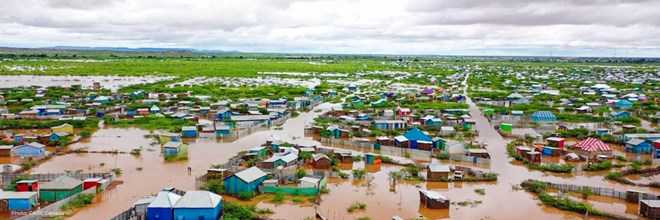
Saturday October 12, 2024

Mogadishu (HOL) — Somalia is at growing risk of climate-induced displacement, with floods expected to drive tens of thousands from their homes annually in the coming decades, according to a new report by the Habitable Project. The report, released in July 2024, warns that flood risks are set to rise significantly due to climate change, which could increase the number of displaced people in Somalia by as much as nine times under pessimistic projections.
Currently, an estimated 17,900 Somalis are displaced by floods each year. These numbers are projected to surge, especially for those living in vulnerable regions such as the Shabelle and Juba river basins, where communities are frequently exposed to seasonal floods.
The Habitable Project’s findings show that Somalia’s displacement problem extends beyond the immediate threat of losing homes. Floods disrupt critical infrastructure, including schools and healthcare facilities, further deepening the crisis for affected populations.
In a severe flood event, up to 16,750 students—0.8% of the school-aged population—could lose access to education due to damaged schools, according to the report. The disruption exacerbates existing vulnerabilities and prolongs the displacement experience for many families.
“Flooding has become more frequent and severe in Somalia, particularly for communities along riverbanks who are most exposed,” said Sylvain Ponserre, lead author of the report from the Internal Displacement Monitoring Centre (IDMC). “As sea levels rise and rainfall becomes more unpredictable, the scale of displacement could become overwhelming if proper interventions are not put in place.”
Somalia’s economy, largely dependent on agriculture and livestock, faces severe challenges as floods routinely destroy crops and grazing lands. The report notes that around 38% of displaced people come from rural farming and pastoralist communities, who often struggle to recover from the loss of their livelihoods.
Comparing Risks Across the Region: Ethiopia and Sudan
Somalia is not alone in facing these challenges. The Horn of Africa is highly vulnerable to climate change-induced flooding. Ethiopia, for example, currently experiences an average of 38,500 annual displacements due to floods. This figure could rise to over 150,000 by the end of the century under similar pessimistic climate scenarios. Sudan faces even greater risks, with flood displacement projected to soar from 170,000 people annually to over 1.6 million by 2100.
The report highlights the need for regional collaboration on disaster risk reduction, as neighbouring countries face similar risks. Improved flood management, early warning systems, and sustainable urban planning are key recommendations for mitigating the impact of floods across the region.
The Habitable Project underscores the need for swift policy intervention to protect Somalia’s vulnerable populations from the growing threat of displacement. The report calls on the Somali government and international stakeholders to invest in flood defences, infrastructure, and community resilience programs.
“Without significant action, we are likely to see displacement on a massive scale,” Ponserre warned. “Governments must prioritize adaptation strategies to ensure communities are prepared to face these mounting risks.”






